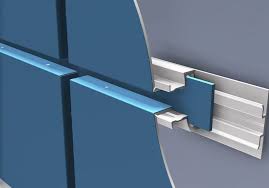Introduction to Aluminum Composite Panel Joining
Aluminum composite panels (ACPs) have revolutionized modern architecture with their versatility, durability, and aesthetic appeal. Whether you’re working on a commercial façade or an interior design project, knowing how to join aluminum composite panels correctly is crucial for ensuring structural integrity and longevity.
Quick Reference Table: ACP Joining Methods
| Method | Strength | Aesthetics | Cost | Ease of Installation |
| Mechanical Fastening | High | Moderate | Low | Easy |
| Adhesive Bonding | High | Excellent | Moderate | Moderate |
| Channel Systems | High | Good | High | Complex |
| Cassette System | Very High | Excellent | High | Complex |
Primary Methods for Joining Aluminum Composite Panels
1. Mechanical Fastening
When learning how to join aluminum composite panel sections using mechanical methods, consider these essential components:
Required Tools:
- Electric drill with appropriate bits
- Torque wrench
- Level
- Measuring tape
- Marking tools
Fastener Types:
- Self-drilling screws (stainless steel)
- Blind rivets
- Through bolts
- Panel clips and cleats
Best Practices for Mechanical Fastening:
- Maintain minimum edge distance (2.5× fastener diameter)
- Pre-drill holes 1mm larger than fastener diameter
- Use appropriate torque settings to prevent panel deformation
- Install EPDM washers for weatherproofing
- Space fasteners 300-600mm apart depending on load requirements
2. Adhesive Bonding
Adhesive bonding is increasingly popular when considering how to join aluminum composite panel sections for a clean appearance.
Recommended Adhesive Types:
- MS Polymer Adhesives:
- UV resistant
- Flexible bond
- Weather-resistant
- Polyurethane Adhesives:
- High strength
- Good elongation properties
- Suitable for exterior use
- Two-Part Epoxy:
- Maximum strength
- Rigid bond
- Best for interior applications
📝 Pro Tip: Always perform a small test bond before proceeding with the full installation when using adhesives.
Detailed Installation Guidelines
Surface Preparation for Adhesive Bonding
Step-by-Step Process:
- Clean Surfaces Thoroughly:
- Use isopropyl alcohol
- Remove all debris
- Ensure dry conditions
- Surface Treatment:
- Light abrasion with fine-grit sandpaper (180-220 grit)
- Dust removal
- Primer application (if required)
- Adhesive Application:
- Apply adhesive in continuous beads
- Maintain consistent bead size
- Use spacer tape to control bond line thickness
- Apply uniform pressure
- Allow full cure (typically 24-72 hours)
Channel System Installation
Channel systems offer a modern approach to joining aluminum composite panels:
Types of Profiles:
- H-profiles for vertical joints
- U-channels for edges
- Z-profiles for horizontal joints
- Custom extrusions for specific details
Installation Requirements:
- Minimum 20mm insertion depth
- 3-4mm expansion allowance
- Proper drainage consideration
- Ventilation gaps
Design Considerations and Technical Requirements
Load Calculations
When determining how to join aluminum composite panel sections, consider these loads:
Wind Load:
- Building height
- Geographic location
- Exposure category
Dead Load:
- Panel weight
- Attachment system
- Additional fixtures
Seismic Considerations:
- Building zone
- Panel size
- Connection flexibility
Environmental Factors
🌡️ Temperature Range Considerations:
- Minimum: -20°C
- Maximum: +80°C
- Expansion Rate: 0.025mm/m/°C
Climate Considerations:
- Humidity exposure
- UV radiation
- Chemical exposure
- Coastal conditions (salt spray)
Quality Control and Safety Measures
Pre-Installation Checklist
- Material inspection
- Structure alignment
- Environmental conditions check
- Tool calibration
- Safety equipment verification
Installation Quality Control
Regular checks during the process of joining aluminum composite panels:
- Bond Testing
- Fastener Torque
- Joint Width Verification
- Level and Plumb Checks
- Weather Sealing
Maintenance and Long-term Care
Maintenance Schedule
| Task | Frequency | Notes |
| Visual Inspection | Quarterly | Check for damage |
| Cleaning | Semi-annual | Use approved cleaners |
| Sealant Check | Annual | Replace if needed |
| Fastener Inspection | Annual | Check torque |
| Full Assessment | 5 Years | Professional inspection |
Troubleshooting Common Issues
Common Problems When Joining Aluminum Composite Panels
Panel Deflection
- Cause: Insufficient support
- Solution: Add intermediate supports
- Prevention: Proper planning and structural analysis
Water Infiltration
- Cause: Poor sealing
- Solution: Sealant replacement
- Prevention: Quality materials and proper joint design
Aesthetic Issues
- Cause: Installation errors
- Solution: Proper techniques and training
- Prevention: Training and quality control measures
FAQs
Frequently Asked Questions
Q: What is the best method for joining aluminum composite panels?
A: The best method depends on your specific application. Mechanical fastening is ideal for removable installations, while adhesive bonding provides a clean appearance for permanent installations.
Q: How long does adhesive bonding take to cure?
A: Typical curing times range from 24-72 hours, depending on environmental conditions and adhesive type.
Q: Can I join aluminum composite panels in cold weather?
A: Most adhesive manufacturers recommend installation temperatures between 5°C and 35°C for optimal results.
Related Keywords and Topics
- ACP installation techniques
- Metal composite material joining
- Architectural panel installation
- Façade system assembly
- Construction panel mounting
- Building cladding installation
Conclusion
Understanding how to join aluminum composite panels correctly is crucial for successful architectural and construction projects. Whether choosing mechanical fastening, adhesive bonding, or channel systems, proper technique and attention to detail ensure lasting results. Remember to consider environmental factors, load requirements, and maintenance needs when selecting your joining method. Always consult local building codes and manufacturer specifications before beginning any installation project. Professional installation is recommended for large-scale applications.


Leave a Reply